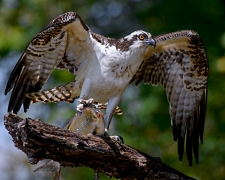Wildlife - Species
Osprey (Pandion haliaetus)
Description
Ospreys, locally known as fish hawks or fish eagles, are the only living representatives of the family Pandionidae and the genus Pandion. They are medium-sized birds (females being larger than males), measuring 53-61 cm (21-24 in) length with a 140-180 cm (55-70 in) wingspan. The osprey's back is brownish black, the breast is white with buff or brown speckles, and the tail is gray with dark bars. A dark stripe extends along the side of the face, through the bird's eye. The wings have characteristic dark "wrist" marks when viewed from below and are "bent" like those of a seagull. Juveniles are similar in appearance to adults, but the upper parts are more streaked and the long wing feathers are brownish-yellow. The adult plumage is gradually acquired through a series of molts and is usually complete when the bird is 18 months old.
Ospreys are specialized for living near water, where fish constitute almost their entire diet. The legs are long and equipped with long, curved talons (claws), and the undersurface of the toes is covered with short spines, or spicules, that allow the bird to hold on to slippery prey. The plumage is dense and oily and enables the osprey to dive into the water, a unique behavior among birds of prey. Other fish eaters, such as the bald eagle, snatch fish from the surface without entering the water.
Preferred Habitat and Biology
The osprey's breeding range extends from Alaska east to Newfoundland and south to Arizona and New Mexico. It also breeds along the Atlantic coast to southern Florida and the Gulf coast. Wintering grounds are north to California and South Carolina and south to Mexico and Chile. Because osprey feed on fish, they must nest in the vicinity of water. The majority of ospreys in the United States are found in marine environments, but inland nesting along rivers, lakes, and reservoirs is also important.
Ospreys select habitat that has suitable perching structures and easy access to fish. Ospreys hover before landing, so they need nesting sites where they can easily land. They have been known to nest on both man-made and natural objects such as cranes, buildings, bridges, nest platforms, telephone poles, or partially rotten trees with no tops. All of these objects allow comfortable landing. Osprey build huge nests which eventually reach "eagle size." They are abundant in the ACE Basin as a result of the expansive saltmarsh and estuarine areas.
Most ospreys found in the United States are migratory birds, with an exception of those in southern Florida. Fall migration occurs from late August to November, peaking in September. They return to breeding grounds from late March to mid-April and begin nest construction or repair (often using the same nest as in the previous year) shortly thereafter. Historically, osprey nests were found on the tops of large dead, and sometimes live trees. Due to the reduced availability of nesting sites in some areas, especially along the mid-Atlantic coast, ospreys now regularly nest on man-made structures such as channel markers. Two to four eggs, pink or buff colored and blotched with brown, are laid in April. Incubation of the eggs, performed mainly by the female, last approximately 38 days. Young fledge at 44 -59 days and may continue to rely on parental care for another 6 weeks. Ospreys reach sexual maturity at 3 years of age. Their diet consists almost exclusively of live fish, although dead ones may be taken occasionally.
Species Significance
The osprey is not listed as threatened or endangered; however it is listed by the U.S. Fish and Wildlife Service as a species of "Special Emphasis." Populations of ospreys, along with those of other birds of prey, declined severely in the United States during the 1950s and 1960s due to pesticide poisoning that caused thinning of eggshells. This species is considered a biological indicator of environmental contamination, mainly of organochlorine pesticides. Ospreys are currently protected under the Migratory Bird Treaty Act and are now abundant in many areas where they had previously disappeared.
References
Bull, J. L. and J. Farrand, Jr. 1995. National Audubon Society Field Guide to North American Birds. Eastern Region. The Audubon Society field guide series. Alfred A. Knopf Inc., New York, NY.
Henny, C. J. 1986. Osprey (Pandion haliaeetus). U.S. Army Corps of Engineers Wildlife Resource Management Manual. Technical Report EL-86-5, Section 4.3.1. United States Fish and Wildlife Service, Patuxent Wildlife Research Center, Patuxent, MD
.Sprunt, A., Jr. and E. B. Chamberlain. 1970. South Carolina bird life. University of South Carolina Press, Columbia, SC.


